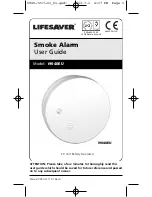
4. Operation and Testing
OPERATION:
The smoke alarm is operating once a fresh battery is
installed and testing is complete. When products of combustion are
sensed, the unit sounds a loud 85db pulsating alarm until the air is
cleared.
HUSH CONTROL:
The “HUSH” feature has the capability of temporarily
desensitizing the alarm circuit for approximately 8 minutes. This feature is
to be used only when a known alarm condition, such as smoke from
cooking, activates the alarm. If the smoke is not too dense, the alarm will
silence immediately and the Red LED will flash once every 10 seconds for
approximately 8 minutes. This indicates that the alarm is in a temporarily
desensitized condition. The smoke alarm will automatically reset after
approximately 8 minutes and sound the alarm if particles of combustion
are still present. The “HUSH” feature can be used repeatedly until the air
has been cleared of the condition causing the alarm.
NOTE: DENSE SMOKE WILL OVERRIDE THE HUSH CONTROL FEA-
TURE AND SOUND A CONTINUOUS ALARM.
CAUTION: BEFORE USING THE ALARM HUSH FEATURE,
IDENTIFY THE SOURCE OF THE SMOKE AND BE CERTAIN A SAFE
CONDITION EXISTS.
FLASHING LED LIGHT:
This smoke alarm is equipped with a flashing
red indicator light. The light is located under the test button and will
flash every 40 seconds to indicate that the smoke alarm is receiving
power.
TESTING:
Test by pushing the test button on the cover and holding it
down for a minimum of 5 seconds. This will sound the alarm if the
electronic circuitry, horn, and battery are working. If no alarm sounds,
the unit has defective batteries or other failure. DO NOT use an open
flame to test your alarm, you could damage the alarm or ignite
combustible materials and start a structure fire.
TEST THE ALARM WEEKLY TO ENSURE PROPER OPERATION.
Erratic or low sound coming from your alarm may indicate a defective
alarm, and it should be returned for service (see section 11).
NOTE: WEEKLY TESTING IS REQUIRED.
Smoke alarms are designed to minimize nuisance alarms. Cigarette smoke
will not normally set off the alarm, unless the smoke is blown directly into
the alarm. Combustion particles from cooking may set off the alarm if the
alarm is located close to the cooking area. Large quantities of combustible
particles are generated from spills or when broiling. Using the fan on a
range hood which vents to the outside (non-recirculating type) will also
help remove these combustible products from the kitchen. If the alarm
does sound, check for fires first. If a fire is discovered, get out and call the
fire department. If no fire is present, check to see if one of the reasons
listed in section 2 may have caused the alarm.
5. Nuisance Alarms
!
0940-7217-01_V1.qxd:_ 2013.7.1 4:18 PM Page 10
















